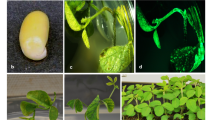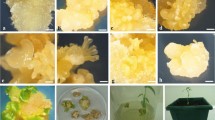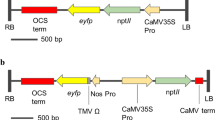Abstract
The utility of transformation for soybean improvement requires an efficient system for production of stable transgenic lines. We describe here an improved cotyledonary node method using an alternative explant for Agrobacterium tumefaciens-mediated soybean transformation. We use the term “half-seed” to refer to this alternative cotyledonary explant that is derived from mature seed of soybean following an overnight imbibition and to distinguish it from cotyledonary node derived from 5–7-day-old seedlings. Transformation efficiencies using half-seed explants ranged between 1.4 and 8.7% with an overall efficiency of 3.8% based on the number of transformed events that have been confirmed in the T 1 generation by phenotypic assay using the herbicide Liberty® (active ingredient glufosinate) and by Southern analysis. This efficiency is 1.5-fold higher than the cotyledonary node method used in our laboratory. Significantly, the half-seed system is simple and does not require deliberate wounding of explants, which is a critical and technically demanding step in the cotyledonary node method.


Similar content being viewed by others
References
An G, Evert PR, Mitra A, Ha SB (1988) Binary vectors. In: Gelvin SB, Schilperoort RA (eds.) Plant molecular biology manual A3. Kluwer Academic Publishers, Dordrecht, pp 1–19
Buising CM, Shoemaker RC, Benbow RM (1994) Early events of multiple bud formation and shoot development in soybean embryonic axes treated with the cytokinin, 6-benzylaminopurine. Am J Bot 81:1435–1448
Carrington JC, Freed DD (1990) Cap-independent enhancement of translation by a plant potyvirus 5′ nontranslated region. J Virol 64:1590–1597
Clemente T, LaVallee BJ, Howe AR, Ward DC, Rozman RJ, Hunter PE, Broyles DL, Kasten DS, Hinchee MA (2000) Progeny analysis of glyphosate selected transgenic soybeans derived from Agrobacterium-mediated transformation. Crop Sci 40:797–803
Dan Y, Reichert NA (1998) Organogenic regeneration of soybean from hypocotyl explants. In Vitro Cell Dev Biol-Plant 34:14–21
Di R, Purcell V, Collins GB, Ghabril SA (1996) Production of transgenic soybean lines expressing the bean pod mottle virus coat protein precursor gene. Plant Cell Rep 15:746–750
Doyle JJ, Doyle JL (1987) A rapid DNA isolation procedure for small quantities of fresh leaf tissue. Phytochem Bull 19:11–15
Droste A, Pasquali G, Bodanese-Zanettini MH (2000) Integrated bombardment and Agrobacterium transformation system: an alternative method for soybean transformation. Plant Mol Biol Rep 18:51–59
Droste A, Pasquali G, Bodanese-Zanettini MH (2002) Transgenic fertile plants of soybean [Glycine max (L.) Merrill] obtained from bombarded embryogenic tissue. Euphytica 127:367–376
Finer KR, Finer JJ (2000) Use of Agrobacterium expressing green fluorescent protein to evaluate colonization of sonication-assisted Agrobacterium-mediated transformation-treated soybean cotyledons. Lett Appl Microbiol 30:406–410
Frame BR, Shou H, Chikwamba RK, Zhang Z, Xiang C, Fonger TM, Pegg SEK, Li B, Nettleton DS, Pei D, Wang K (2002) Agrobacterium tumefaciens-mediated transformation of maize embryos using a standard binary vector system. Plant Physiol 129:13–22
Gamborg OL, Miller RA, Ojima K (1968) Nutrient requirements of suspension cultures of soybean root cells. Exp Cell Res 50:151–158
Hadi MZ, McMullen MD, Finer JJ (1996) Transformation of 12 different plasmids into soybean via particle bombardment. Plant Cell Rep 15:500–505
Hajdukiewicz P, Svab Z, Maliga P (1994) The small versatile pZP family of Agrobacterium binary vectors for plant transformation. Plant Mol Biol 25:989–994
Hinchee MAW, Connor-Ward DV, Newell CA, McDonnell RE, Sato SJ, Gasser CS, Fischhoff DA, Re DB, Fraley RT, Horsch RB (1988) Production of transgenic soybean plants using Agrobacterium-mediated DNA transfer. Biotechnology 6:915–922
Hood EE, Helmer GL, Fraley RT, Chilton MD (1986) The hypervirulence of Agrobacterium tumefaciens A281 is encoded in a region of pTiBo542 outside of T-DNA. J Bacteriol 168:1291–1301
Ko T, Lee S, Krasnyanski S, Korban SS (2003) Two critical factors are required for efficient transformation of multiple soybean cultivars: Agrobacterium strain and orientation of immature cotyledonary explant. Theor Appl Genet 107:439–447
Koscianska E, Wypijewski K (2001) Electroporated intact BY-2 tobacco culture cells as a model of transient expression study. Acta Biochim Pol 48:657–661
Liu H, Yang C, Wei Z (2004) Efficient Agrobacterium tumefaciens-mediated transformation of soybeans using an embryonic tip regeneration system. Planta 219:1042–1049
Mason HS, DeWald D, Mullet JE (1993) Identification of a methyl jasmonate-responsive domain in the soybean vspB promoter. Plant Cell 5:241–251
Meurer CA, Dinkins RD, Collins GB (1998) Factors affecting soybean cotyledonary node transformation. Plant Cell Rep 18:180–186
Murashige T, Skoog F (1962) A revised medium for rapid growth and bioassays with tobacco tissue cultures. Physiol Plant 15:473–479
Odell JT, Nagy F, Chua NH (1985) Identification of DNA sequences required for activity of the cauliflower mosaic virus 35S promoter. Nature 6:810–812
Olhoft PM, Flagel LE, Donovan CM, Somers DA (2003) Efficient soybean transformation using hygromycin B selection in the cotyledonary-node method. Planta 216:723–735
Olhoft PM, Lin K, Galbraith J, Nielsen NC, Somers DA (2001) The role of thiol compounds in increasing Agrobacterium-mediated transformation of soybean cotyledonary-node cells. Plant Cell Rep 20:731–737
Parrott WA, Hoffman LM, Hildebrand DF, Williams EG, Collins GB (1989) Recovery of primary transformants of soybean. Plant Cell Rep 7:615–617
Paz MM, Shou H, Guo Z, Zhang Z, Banerjee AK, Wang K (2004) Assessment of conditions affecting Agrobacterium-mediated soybean transformation using the cotyledonary node explant. Euphytica 136:167–179
Saka H, Voqui-Dinh TH, Cheng T (1980) Stimulation of multiple shoot formation on soybean stem nodes in culture. Plant Sci Lett 19:193–201
Santarem ER, Finer JJ (1999) Transformation of soybean [Glycine max (L.) Merrill] using proliferative embryogenic tissue maintained on semi-solid medium. In Vitro Cell Dev Biol Plant 35:451–455
Santarem ER, Trick HN, Essig JS, Finer JJ (1998) Sonication-assisted Agrobacterium-mediated transformation of soybean immature cotyledons: optimization of transient expression. Plant Cell Rep 17:752–759
Somers DA, Samac DA, Olhoft PM (2003) Recent advances in legume transformation. Plant Physiol 131:892–899
Townsend JA, Thomas LA (1993) An improved method of Agrobacterium-mediated transformation of cultured soybean cells. US Patent WO 94/02620
Vancanneyt G, Schmidt R, O'Connor-Sanchez A, Willmitzer L, Rocha-Sosa M (1990) Construction of an intron-containing marker gene: splicing of the intron in transgenic plants and its use in monitoring early events in Agrobacterium-mediated plant transformation. Mol Gen Genet 220:245–250
White J, Chang SP, Bibb MJ, Bibb MJ (1990) A cassette containing the bar gene of Streptomyces hygroscopicus: a selectable marker for plant transformation. Nucl Acids Res 18:1062
Wright MS, Koehler SM, Hinchee MA, Carnes MG (1986) Plant regeneration by organogenesis in Glycine max. Plant Cell Rep 5:150–154
Wroblewski T, Tomczak A, Michelmore R (2005) Optimization of Agrobacterium-mediated transient assays of gene expression in lettuce, tomato and Arabidopsis. Plant Biotechnol J 3:259–273
Wu FS, Feng TY (1999) Delivery of plasmid DNA into intact plant cells by electroporation of plasmolyzed cells. Plant Cell Rep 18:381–386
Yan B, Reddy MSS, Collins GB, Dinkins RD (2000) Agrobacterium tumefaciens– mediated transformation of soybean [Glycine max (L.) Merrill] using immature zygotic cotyledon explants. Plant Cell Rep 19:1090–1097
Zeng P, Vadnais DA, Zhang Z, Polacco JC (2004) Refined glufosinate selection in Agrobacterium-mediated transformation of soybean [Glycine max (L.) Merrill]. Plant Cell Rep 22:478–482
Acknowledgements
The authors thank Joanna Harbaugh, Amanda Ehrler and Francois Torney for their technical assistance; Mike Webber, Bayer CropScience, USA for graciously giving us Liberty® herbicide; and Bronwyn Frame and John Pesek for critical review of the manuscript and valuable suggestions. This work was partially supported by the Iowa Soybean Promotion Board and the North Central Soybean Research Program.
Author information
Authors and Affiliations
Corresponding author
Additional information
Communicated by J. C. Register
An erratum to this article can be found at http://dx.doi.org/10.1007/s00299-005-0113-2
Rights and permissions
About this article
Cite this article
Paz, M.M., Martinez, J.C., Kalvig, A.B. et al. Improved cotyledonary node method using an alternative explant derived from mature seed for efficient Agrobacterium-mediated soybean transformation. Plant Cell Rep 25, 206–213 (2006). https://doi.org/10.1007/s00299-005-0048-7
Received:
Revised:
Accepted:
Published:
Issue Date:
DOI: https://doi.org/10.1007/s00299-005-0048-7




